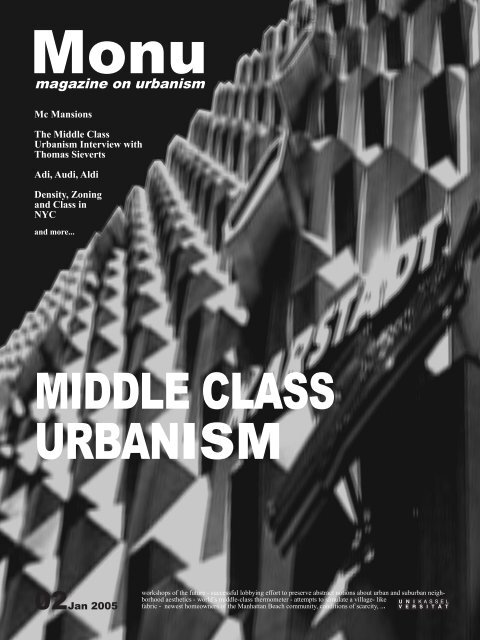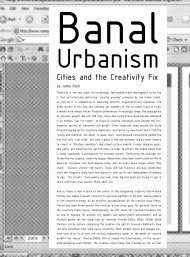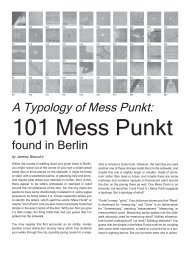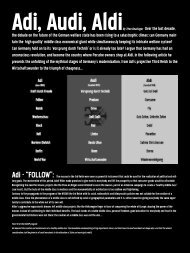MIDDLE CLASS URBANISM - magazine for urban documentation ...
MIDDLE CLASS URBANISM - magazine for urban documentation ...
MIDDLE CLASS URBANISM - magazine for urban documentation ...
You also want an ePaper? Increase the reach of your titles
YUMPU automatically turns print PDFs into web optimized ePapers that Google loves.
Monu<br />
<strong>magazine</strong> on <strong>urban</strong>ism<br />
Mc Mansions<br />
The Middle Class<br />
Urbanism Interview with<br />
Thomas Sieverts<br />
Adi, Audi, Aldi<br />
Density, Zoning<br />
and Class in<br />
NYC<br />
and more...<br />
<strong>MIDDLE</strong> <strong>CLASS</strong><br />
<strong>URBANISM</strong><br />
02Jan 2005<br />
workshops of the future - successful lobbying ef<strong>for</strong>t to preserve abstract notions about <strong>urban</strong> and sub<strong>urban</strong> neigh-<br />
borhood aesthetics - world’s middle-class thermometer - attempts to simulate a village- like<br />
fabric - newest homeowners of the Manhattan Beach community, conditions of scarcity, ...<br />
U N I K A S S E L<br />
V E R S I T Ä T
For the last few decades the middle class has been the driving <strong>for</strong>ce behind <strong>urban</strong> innovation.<br />
More than any other, this <strong>urban</strong> group has both the financial resources and the sheer power of<br />
numbers to effectively trans<strong>for</strong>m desire into <strong>urban</strong> reality. Many of the most obvious components<br />
of our cities--Row houses, apartment buildings and sports facilities, to name but a few—are in<br />
large measure a function of the existence of a broad middle class.<br />
The middle class symbolizes modest <strong>urban</strong> values, values that seem hopelessly anti-utopian and<br />
run counter to the megalomaniac concepts of cities proposed by great architects like LeCorbusier<br />
or Hilbersheimer. But in reality the middle class is comprised of some of the boldest <strong>urban</strong><br />
utopists ever, individuals who have been realizing their utopias <strong>for</strong> decades. Much less dogmatic<br />
and more successful than any imagined utopia, with their power, influence and sheer numbers the<br />
middle class has shaped the <strong>urban</strong> landscapes we inhabit today.<br />
But there is also something paradox about the middle-class when it comes to <strong>urban</strong>ism: On the<br />
one hand the common wisdom is that middle class households are integral to a balanced social<br />
structure in a city but at the same time their relation to <strong>urban</strong> environments seems to be ambivalent<br />
to say the least. Beth Lieberman’s analysis shows how middle class residents in low density<br />
neighborhoods in New York City epitomize that paradox. They fiercely resent any increase in<br />
density - in <strong>urban</strong>ization in their neighborhood. And at the same time the declared policy of the<br />
city to hold on to it’s middle class and not let it move out to New Jersey or Long Island, gives these<br />
homeowners a political clout and ultimately an influence over the zoning process that stands in no<br />
relationship to their numbers.<br />
And although the term middle class very blurry it might be exactly the contradictory relation of<br />
middle class to cities that could lead to a definition of what is the middle-class. As Johannes Fiedler<br />
argues in his text ‘Dispersion’, in the absence of scarcity of some sort (e.g. economic, security)<br />
or top-down regulations, the default choice <strong>for</strong> living seem to be dispersed, low density environments.<br />
Or as Thomas Sieverts in our interview put it: ‘people seek the fringes’. It is almost a pioneer-like<br />
quality that parts of the middle class exhibit – the constant search <strong>for</strong> the new fringe, the<br />
new land. The relatively new phenomenon of exurbs is the US expression of that impulse. Places<br />
that are ever further removed from the population centers almost completely disconnected from<br />
any <strong>for</strong>m of civic life. In Europe or Germany this strategy is not an option due to lack of available<br />
open space. Instead in Berlin, as documented in the article by Katherine Bourke and Gregor Harbusch,<br />
spaces in between old and new cities are the new frontier – the new fringe that the middleclass<br />
colonizes.<br />
The complex and contradictory behavior of the middle class in an <strong>urban</strong> sense begs <strong>for</strong> an economic<br />
definition of middle class. Middle class, broadly defined, are those that have a significant<br />
amount of disposable income. This economic status af<strong>for</strong>ds them the choice between different<br />
styles of housing and one could argue it is part of what distinguishes a middle class lifestyle from<br />
those living under strict financial constraints or in poverty.<br />
In most developed market-societies the choice of place is only confined by the resources available<br />
(government interventions usually are only feeble attempts to channel those <strong>for</strong>ces and produce<br />
more unintended than intended effects). And so, while the presence and the economic stability of<br />
the middle class is a social and fiscal necessity <strong>for</strong> any city, at the same time, their economic equip<br />
af<strong>for</strong>ds them the option to turn their back on the city, settle in new areas and set up an own counter-reality<br />
to old civic <strong>for</strong>ms and traditions. The middle class, one could argue, is thus also
in an almost physical/architectural sense a critical <strong>urban</strong> component: Unlike lower class households,<br />
middle class families have a choice of where they want to settle and, unlike the numerically<br />
smaller upper stratum of a society, they are a quantitatively significant entity. And the places they<br />
choose to settle are then subject to large-scale trans<strong>for</strong>mation. The peripheries of cities were radically<br />
changed with the emergence of a large, mobile middle class. The suburb, probably the most<br />
important <strong>urban</strong> invention of the 20th century is arguably a middle class creation. And <strong>for</strong> a long<br />
time the demise of cities, their dissolving in a sea of suburbs was seen as the inevitable conclusion.<br />
However, the option of leaving the city is not always realized, and there is ample evidence that the<br />
classical suburb itself is already under siege, from the emergence of exurbs and to some extent<br />
also from the old cities itself. Nevertheless the competition is about middle-class residents and that<br />
competition between the cities and their periphery. No matter who will win in the end, the results<br />
will change the shape of our cities profoundly. Fernando Vegas describes how the reestablishing of<br />
the middle-class in central cities in Spain is connected to wide-ranging changes in the morphologies<br />
of those centuries old cities. In a similar sense William Alatriste’s photographs document the<br />
architectural dimension of a new immigrant group in Brooklyn establishing itself in the American<br />
way of life.<br />
At the same time there are signs that at least in the US, middle class lifestyle is increasingly<br />
coming under pressure. Foreclosure rates in sub<strong>urban</strong> America and bankruptcy filings are at<br />
record highs, saving rates are at a record low. It seems that the safe haven of the middle class<br />
home is becoming a financial risk <strong>for</strong> more and more homeowners. With mortgages often barely<br />
af<strong>for</strong>dable with two incomes in a family – the slightest disruption, a lost job, a sick family member<br />
etc. can mean the abrupt end of the dream.<br />
But while the classic suburb in the Western World might be experiencing its own first crisis this<br />
model <strong>for</strong> middle class living seems to be just taking off in other places. Angie Waller reports from<br />
China how places from Long Island to Orange County become role models <strong>for</strong> the burgeoning<br />
middle class in <strong>urban</strong> China.<br />
Although the middle class is difficult to define and it’s consequences <strong>for</strong> <strong>urban</strong> regions are sometimes<br />
contradictory, we think that the existence of the middle class as a social and <strong>urban</strong> phenomenon<br />
cannot be dismissed and is worth careful inquiry as well as wild speculation. Our second<br />
issue of Monu is a contribution in that spirit and the bandwidth and extraordinary quality of<br />
texts, projects and graphics we received <strong>for</strong> this issue proof the point.<br />
We would like to thank all authors <strong>for</strong> their contributions, William Alatriste <strong>for</strong> copyediting some<br />
of the English translations and the Center <strong>for</strong> Urban Architectural Studies at the University of<br />
Kassel <strong>for</strong> its generous support.<br />
The Editors<br />
Thomas Soehl<br />
Bernd Upmeyer<br />
Title photograph:<br />
In the summer of this year the symbol <strong>for</strong> the German middle class consumer culture filed <strong>for</strong> bankruptcy. Karstadt/Quelle a brand that<br />
operated one of the most popular chains of large multi-department stores and Germanys most successful shopping catalogue had been<br />
an architectural institution in German city centers as well as a printed one in rural and sub<strong>urban</strong> living rooms.
Contact/ editors@monu.org<br />
Article<br />
submission<br />
Internetmag www.monu.org<br />
Title Picture Karstadt in Dresden, Germany<br />
Editors Thomas Söhl and Bernd Upmeyer<br />
Publisher University of Kassel<br />
Departement of Architecture, Townplanning, Landscapeplanning<br />
Faculty: Entwerfen im städtebaulichen Kontext<br />
Urban Architectural Studies UAS<br />
Prof. Wolfgang Schulze<br />
Gottschalkstrasse 30<br />
34127 Kassel, Germany<br />
phone: 0049 561 8042309; fax: 0049 561 8043209<br />
www.uni-kassel.de/ fb6/ Entwerfen im städtebaulichen Kontext/ UAS<br />
Printing Bräuning + Rudert oHG<br />
Druckwerkstatt<br />
Weimarer Weg 50<br />
34314 Espenau, Germany<br />
phone: 0049 5673 913157<br />
fax: 0049 5673 911751<br />
bs@druckwerkstatt-br.de<br />
Order address mail:<br />
info-isp@uni-kassel.de www.isp.uni-kassel.de<br />
analog:<br />
Universität Kassel, Fb 6 Infosystem Planung<br />
Henschelstrasse 2<br />
34127 Kassel, Germany phone: 0049 561 8042016<br />
fax: 0049 561 8042232<br />
ISSN<br />
Call <strong>for</strong> submissions <strong>for</strong> Monu 3.0<br />
Politcal Urbanism - the relations of <strong>urban</strong> <strong>for</strong>m and typology<br />
to ideology, power and politics<br />
For our third issue of Monu we invite articles, projects, photographs, artwork, research projects and<br />
wild speculations that are engaged in the field power/politics and <strong>urban</strong> <strong>for</strong>m/typology on any level.<br />
Interested contributors should contact the editors ASAP at editors@monu.org. The deadline <strong>for</strong> contributions<br />
will be the end of April 2005.<br />
scale 1:1.000.000<br />
The red state – blue state phenomenon became commonplace even in Europe in the last years: Democrats have the upper hand in the coastal<br />
states and republicans in the rest of the country. But not only the US have a particular map when it comes to politics – traditionally<br />
the two most southern states of Germany have also been the most conservative ones. In Bavaria the conservative party had a hold on execu<br />
tive and legislative <strong>for</strong> almost 60 years now and achieved that state and the party are virtually synonymous in perception; the political party as<br />
a brand <strong>for</strong> an entire state.<br />
scale 1:10.000<br />
NY Times columnist David Brooks conceptualized exurbia as a place that houses a certain value-system and political convictions. Exurbs are<br />
communities that are both spatially and functionally virtually completely detached from <strong>urban</strong> centers. And they are as Brooks argues, communities of<br />
conservative, family value oriented households. In the 2004 presidential election, while Democrats generally did well in <strong>urban</strong> regions – George Bush<br />
and the Republicans generally won overwhelmingly in those new communities on the fringes of <strong>urban</strong> life.<br />
scale 1:1.000<br />
New <strong>urban</strong> typologies such as shopping malls, office parks and gated communities or new <strong>urban</strong>ism towns create their own political<br />
microclimate. Classical democratic principles as invented in the polis and developed in democratic cities and regions over centuries<br />
seem to be suspended in these environments. In a mall you buy your right to existence with your identity as a consumer and the<br />
security guards are en<strong>for</strong>cing house rules that have been drawn up in corporate boardrooms. The inhabitants of gated<br />
communities or other post-modern residential typologies together with the purchase contract generally also sign<br />
away part of their civil liberties. Given that these and similar kinds of typologies are becoming more and<br />
more parts of our <strong>urban</strong> environment what are the larger consequences of these per<strong>for</strong>ations<br />
of the democratic process and the civic space?
Contents<br />
Dispersion by Johannes Fiedler Page 6 – 10<br />
Density, Zoning, and Class in New York City by Beth Lieberman Page 11 – 14<br />
Mc Mansions by William Alatriste Page 15 – 20<br />
Urbanism <strong>for</strong> the Middle Class in historic city centers by Fernando Vegas and Camilla Mileto Page 21 – 23<br />
Middle Class Urbanism: Interview with Thomas Sieverts Page 24 – 29<br />
IKEA: When Cathedrals were blue by Manuel Shvartzberg Page 30 – 35<br />
Neu Karow: a new space between berlin’s past and its border by Katherine Bourke and Gregor Harbusch Page 36 – 38<br />
Landscape Urbanism by Detlev Ipsen and Holger Weichler Page 39 – 47<br />
circuitous by Leah Beeferman Page 48<br />
Adi, Audi, Aldi by Theo Deutinger Page 49 – 51<br />
Middle Class Emulations by Angie Waller Page 52 – 54<br />
The New Middle Class by Robert Winkel Page 55 – 57<br />
Middle Class Desires by UAS Page 58 – 64<br />
Book review: Integrated Perspectives on Places of Modernity Page 65<br />
by Kai Jonas





